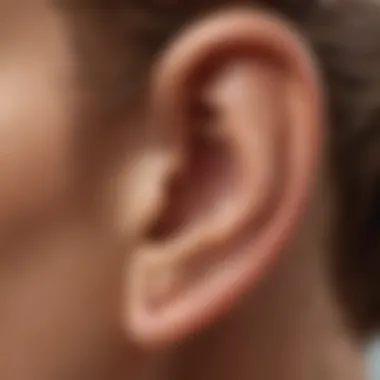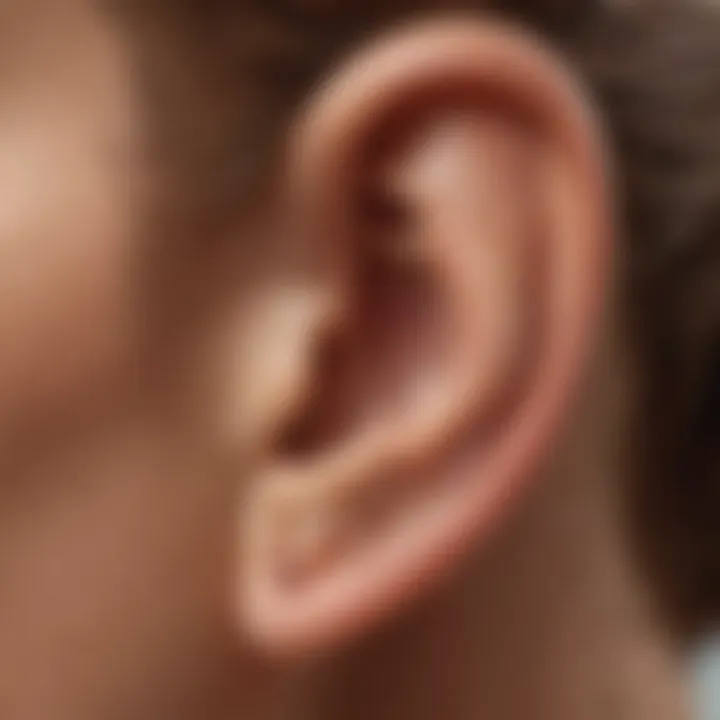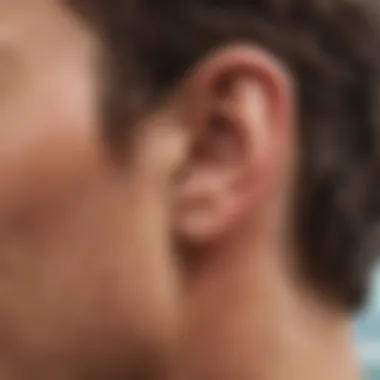Understanding Eardrum Injury: Symptoms and Care


Intro
Eardrum injuries might not be something most people think about until there's a problem. Understanding how to spot such an injury can be incredibly beneficial. After all, the eardrum plays a vital role in our ability to hear and communicate. When it takes a hit, it not only affects your hearing but can also lead to a series of medical issues down the line.
Recognizing the signs of an eardrum that has come to harm is the first step in addressing the issue. From potentially disastrous causes—like severe infections or sudden pressure changes—to more mundane, yet just as damaging, activities like diving or loud noises, the risk factors vary widely. When we talk about symptoms, some people might experience sudden pain, temporary loss of hearing, or even a strange ringing sound that just won’t go away.
This overview aims to provide a detailed guide that helps you identify the key aspects of eardrum injuries. It covers why it's important to seek help if you suspect something's amiss, what the middle ear does, and what kind of treatments might be in line for recovery. Plus, we will tap into preventative measures so we can all keep our hearing in check.
By arming yourself with this knowledge, you stay a step ahead, ensuring the health of one of our most precious senses—hearing.
Understanding the Eardrum's Role
Grasping the significance of the eardrum is fundamental to understanding how ear injuries can affect overall hearing. The eardrum, also known as the tympanic membrane, is a thin layer of tissue that separates the outer ear from the middle ear. This simple, yet essential structure carries more weight than one might think, contributing not only to the hearing process but also acting as a protective barrier against infection and injury.
Anatomy of the Ear
The architecture of the ear is quite intricate, playing a key role in its functionality. The ear is divided into three sections: the outer ear, middle ear, and inner ear.
- Outer Ear: This includes the visible part of the ear, called the pinna, which collects sound waves and funnels them into the ear canal.
- Middle Ear: The eardrum resides in this section, serving as a bridge between the outer world and the inner workings of the auditory system. It vibrates in response to sound waves and transmits those vibrations to the ossicles, three tiny bones named the malleus, incus, and stapes.
- Inner Ear: Here, sound waves are converted into neural signals and transmitted to the brain for interpretation.
Understanding these components is essential when discussing eardrum injuries and their implications.
Functionality of the Eardrum
The eardrum is not merely a membrane; it has an invaluable role in hearing. When sound waves hit the eardrum, it vibrates, and these vibrations travel through the ossicles into the cochlea of the inner ear, completing the sound transmission pathway.
- Air Pressure Regulation: The eardrum also helps equalize air pressure in the middle ear, which is crucial when traveling, especially in airplanes or while diving. A sudden change in pressure can lead to discomfort and potential injury.
- Protective Barrier: Acting as a guard, the eardrum helps prevent harmful substances from entering the deeper structures of the ear, which could lead to infections and other complications.
These aspects of the eardrum's function become pivotal to consider when recognizing potential injuries. Damage to this small but mighty membrane can lead to myriad issues, ranging from mild discomfort to significant hearing loss. It's clear that every snorkeler, diver, or beachside enthusiast should be aware of how vital their eardrums are to their enjoyment of aquatic activities and their overall auditory health.
Mechanisms of Injury
Understanding the mechanisms behind eardrum injury is critical for grasping how to protect hearing health. This section unravels the various contexts and situations in which the eardrum may sustain damage. Recognizing the underlying causes can help individuals, especially those engaged in adventurous activities like surfing or marine biology, to be more vigilant and proactive. The eardrum, or tympanic membrane, serves as a crucial barrier between external and middle ear environments. Thus, any disruption to its integrity not only affects hearing but can also precipitate further complications.
Causes of Eardrum Rupture
Eardrum ruptures can result from a variety of factors, each with different implications for exploration and daily life. Here’s a detailed look at some of the more common causes:
- Acoustic Trauma: Loud sounds or explosions can cause instantaneous pain and potential rupture. For surfers, unexpected loud noises such as boat horns or cannon fire in nearby events can pose risks.
- Pressure Changes: Sudden shifts in atmospheric pressure can be particularly hazardous. Activities such as deep diving or even flying can lead to pressure imbalances, particularly during ascents or descents.
- Physical Injury: Direct trauma from objects penetrating the ear canal may lead to ruptures. For example, a surfboard hitting the ear while wiping out can result in severe impact.
- Infections and Fluid: Conditions like otitis media often lead to fluid buildup, which can create enough pressure to rupture the eardrum. This is often seen in individuals vulnerable to recurrent infections.
Knowing these causes emphasizes the importance of personal awareness and preventive strategies. Individuals can better navigate their environments and anticipate situations that may compromise ear safety.
Understanding Barotrauma
Barotrauma specifically describes injuries resulting from pressure changes and is an essential topic for those regularly in aquatic environments. This condition can notably affect surfers and divers who routinely experience rapid underwater descents or ascents.
- How it Happens: When the pressure of the outside environment changes substantially and the ear fails to equalize properly, it can create significant discomfort. Symptoms range from mild ear pain to severe ruptures.
- Preventive Measures: Learning techniques such as the Valsalva maneuver can help mitigate the risks. This method involves a careful approach to equalizing ear pressure, assisting in avoiding injuries during dramatic pressure changes.
- Awareness During Activities: Being conscious of ear pressure while engaged in water sports can make a crucial difference in preventing injury. Surfers should be cautious about their position relative to surf and currents that could unexpectedly change pressure situations.
"Being aware of environmental factors that lead to barotrauma can save not only your surfing session, but also protect your hearing for a lifetime."
Overall, diving into the mechanisms of eardrum injury sheds light on how to safeguard one of the body's most delicate systems. Whether through education, awareness, or sensible preventive strategies, understanding these concepts supports not only recreational enjoyment but long-term hearing health.
Identifying Signs of a Busted Eardrum
Recognizing the signs of a busted eardrum is of utmost importance, especially for those with a lifestyle that involves frequent exposure to water and sound, such as surfers and beach lifeguards. Identifying these signs early on can lead to timely medical intervention, which might just save one from further complications and ensure a better recovery trajectory. Awareness of these indicators not only helps in safeguarding one's health but also enables one to educate peers about the relevance of ear health in their own pursuits.
Common Symptoms
Understanding common symptoms associated with a busted eardrum is essential. These symptoms often act as beacons intended to alert an individual that something is amiss, urging them to seek further evaluation or treatment.
Pain in the Ear
Pain in the ear is one of the most prevalent signs of eardrum injury. This discomfort often presents itself as a sharp or dull ache, varying widely from person to person. The key characteristic of this pain is its immediacy; it tends to appear rather suddenly, particularly after an incident like a significant noise exposure or a sudden change in pressure. For surfers, who might experience drastic environmental shifts, it's a common indicator.


The unique aspect of pain in the ear is that it is not merely a signal that alerts to danger, but it can also be quite debilitating, affecting one’s ability to carry out routine activities. While it has immediate implications, the longer-term message it sends is irreplaceable: this is the body’s way of demanding attention.
Fluid Discharge
Another troubling symptom is fluid discharge, which could either be clear or bloody. This is a clear indication that the eardrum has sustained a tear or rupture, allowing fluids to escape from the middle ear. The fluid can vary in consistency and indicate different issues. What stands out about this indicator is its visibility; it becomes hard to ignore, as it requires one to confront the potential severity of the situation.
This symptom’s unique feature lies in its potential to serve as a diagnostic tool. For medical professionals, the nature of the discharge can provide insight into underlying conditions, offering clues that lead to a more accurate medical response. On the flip side, such discharge can be socially stigmatizing for the individual, making it imperative for education around the topic to mitigate potential embarrassment.
Changes in Hearing
Changes in hearing are a hallmark symptom of a busted eardrum. Individuals may experience muffled sounds or, in some cases, a total loss of hearing in the affected ear. The characteristic of this symptom is its variability; while some may describe it as a damping effect, others might find certain frequencies harder to discern. This can be alarming, particularly for individuals regularly engaging with oceanic environments where auditory cues are vital for safety.
The unique feature of changes in hearing is its profound impact on daily life. Not only do these shifts affect communication, but they also pose risks for those whose activities require acute auditory awareness, such as lifeguards. The advantage of recognizing hearing changes as a symptom enables rapid response to address potential damage before it becomes permanent.
Other Notable Indicators
Recognizing other notable indicators can also prove crucial in understanding the larger scope of eardrum injury. These indicators may not be as commonly discussed but are equally impactful.
Tinnitus
Tinnitus presents as a ringing or buzzing sound in one or both ears and can be subtle or overwhelming. It's a phenomenon where one hears sounds that are not sourced externally. The key characteristic of tinnitus is that it often accompanies other symptoms, such as pain or hearing loss, merging into a complex symptomatology that calls for concern.
This unusual auditory experience can greatly affect quality of life, leading to concentration issues or heightened anxiety. Recognizing tinnitus as a legitimate symptom informs individuals of its significance and engages them in a dialogue about ear health where they might previously have felt alone in their experiences.
Dizziness and Balance Issues
Lastly, dizziness and balance issues can arise following a eardrum injury. Individuals may feel a sense of vertigo or find their coordination compromised, which can be particularly precarious for someone who regularly navigates aquatic environments. This symptom’s key characteristic includes a sense of disorientation that can manifest itself in various ways, such as feeling lightheaded or unsteady.
This feature of dizziness deserves attention because it can flag serious complications, like infection or widespread vestibular dysfunction. For outdoor enthusiasts, the implications can be severe, as compromised balance affects not just their safety but that of others around them as well.
Collectively, these signs illustrate a larger narrative about ear health and underscore the importance of seeking prompt medical evaluation when symptoms arise. Protecting one's hearing is not just a personal concern; it's essential for the well-being of communities engaged in potential risk exposures.
Initial Self-Assessment
When it comes to eardrum injuries, getting ahead of the game is crucial. The process of initial self-assessment serves as a first line of defense. It gives individuals a chance to check in with their symptoms before diving into the medical system. Knowing what you’re dealing with can help ease worries and even guide your next steps effectively. This part of the journey is not just about identifying symptoms; it’s about understanding their significance and how they could correlate to an eardrum issue.
Evaluating Symptoms
Evaluating symptoms is where the rubber meets the road. It entails paying close attention to what your body is telling you. Some symptoms might be blaring alarms, while others may whisper concerns. Being alert to changes is essential. If there’s pain in your ear or unexpected fluid discharge, it’s time to take a closer look.
Ignoring signs can lead to complications and may prolong discomfort. Start by asking yourself: How intense is the pain? Is it sharp, throbbing, or dull? Does anything gurgle or pop in your ear? Consider if there’s been any recent exposure to loud noises or changes in pressure. Each of these factors can add valuable context to your symptoms.
When to Seek Medical Attention
Knowing when to reach out for help can be tricky but knowing what signals to heed can save you a world of trouble.
Persistent Symptoms
Persistent symptoms are those that just refuse to go away, no matter what you do. When a pain lingers on or drainage keeps making unwanted appearances, it's often a signal that something might be off. This is not merely a momentary nuisance—persistent symptoms generally suggest that an underlying issue is at play.
Many people often brush these off, thinking they'll just heal with time. Yet, their stubborn nature indicates that it warrants a closer examination. Should symptoms continue beyond what would be considered normal healing time, don't hesitate to consult a healthcare provider. Ignoring this warning can lead to more severe complications, which would be a hefty price to pay for a small sidestep.
Sudden Changes in Hearing
Now, sudden changes in hearing, that’s like the alarm bells ringing loud and clear. If you've been enjoying your tunes and suddenly everything sounds muted or distorted—or worse, you can’t hear anything—this demands swift attention. This type of change is a clear red flag that shouldn’t be ignored.
The unique characteristic of sudden changes is that they can often indicate more serious damage, such as a ruptured eardrum or even conditions affecting the bones in the ear. Ignoring this could result in lasting hearing loss or other complications. Being proactive in this regard adds an essential layer of protection for your overall ear health. Just remember, it's always wise to err on the side of caution when your hearing is at stake.
Pro tip: If any symptoms arise that cause concern, better to be safe than sorry. Your ears are important allies in your daily life.
Diagnostic Procedures
Understanding the diagnostic procedures is crucial when it comes to eardrum injuries. These methods play a pivotal role in identifying the specific issues affecting an individual’s ear. Not only do they help in confirming a diagnosis, but they also guide healthcare providers in determining the best treatment pathway. Having clear guidelines and techniques for diagnosis can mean the difference between effective treatment and prolonged discomfort.
Medical Examination Overview


A medical examination serves as the foundation for diagnosing an eardrum issue. Typically, this involves a thorough physical examination of the ear conducted by a qualified healthcare professional. During this examination, the doctor will often check for any visible signs of damage to the eardrum, such as tears or other anomalies that may indicate injury.
- Patient History: The clinician will begin by gathering a detailed medical history, which includes any recent ear infections, trauma, or exposure to loud noises. Knowing a patient’s history helps understand potential risks that could have led to the injury.
- Visual Inspection: Using an otoscope, the doctor can examine the ear canal and eardrum in more detail. They look for redness, swelling, or any fluid build-up, which could indicate infection or a perforation.
- Symptom Evaluation: The clinician will also evaluate the patient’s reported symptoms. Pain, hearing loss, or discharge can provide important clues that lead to identifying the severity of the injury.
Imaging Techniques
When a physical examination isn’t conclusive, imaging techniques may come into play. These procedures offer a more in-depth view of the inner workings of the ear, which is essential in complex cases. Two primary imaging techniques often employed are otoscopy and CT scans.
Use of Otoscopy
Otoscopy is the primary tool used to assess eardrum conditions. This device shines a light into the ear canal, allowing healthcare professionals to visualize the eardrum directly. One key characteristic of otoscopy is that it offers immediate insights into the state of the eardrum, making it a beneficial choice for quick assessments.
Unique Feature: The otoscope’s ability to magnify the eardrum and surrounding tissue enables doctors to discern various conditions—be it a perforation or fluid accumulation.
Advantages: This method is non-invasive and can be done in a typical clinic setting without the need for advanced imaging equipment, making it accessible.
Disadvantages: However, otoscopy has its limits. While it provides a good look at the eardrum and ear canal, it may not reveal underlying issues that require more sophisticated diagnostic tools.
Role of CT Scans
In more complicated cases, CT scans serve as an important imaging technique. This method uses X-rays to create detailed cross-sectional images of the ear structures. One standout aspect of CT scans is their ability to visualize not only the eardrum but also the surrounding bone and soft tissues, which is crucial in revealing broader conditions that might be affecting hearing.
Unique Feature: CT scans can detect hidden fractures or abnormalities of the bony structures surrounding the ear, such as the temporal bone.
Advantages: This imaging technique provides a comprehensive view, making it invaluable for serious injuries or suspected complications.
Disadvantages: On the downside, CT scans involve radiation exposure and may not always be necessary for every patient. Therefore, they are often reserved for when a previous examination indicates a need for further investigation.
Overall, these diagnostic procedures—be it through a straightforward otoscopic examination or advanced imaging like CT scans—ensure that healthcare providers can accurately assess and address eardrum injuries, laying a solid foundation for effective treatment.
Treatment Approaches
Understanding the various treatment approaches for eardrum injuries is crucial for effective recovery and the preservation of hearing. This section sheds light on both non-invasive treatments and surgical options, providing insights into the benefits and considerations for each method. Recognizing the appropriate treatment strategy can make the difference between swift healing and potential long-term complications.
Non-Invasive Treatments
Non-invasive treatments are often the first line of defence in managing eardrum injuries. They are typically preferable for most patients, primarily because they carry fewer risks compared to surgical interventions.
Pain Management
Pain management is an essential aspect of non-invasive treatments for eardrum injuries. It aims to alleviate discomfort while allowing the healing processes to unfold. The key characteristic of pain management in this context is its adaptability; patients can often rely on over-the-counter medications, such as ibuprofen or acetaminophen, to address their pain levels. These options are not only accessible but also serve as a beneficial choice due to their effectiveness in reducing inflammation and discomfort.
A unique feature of pain management is that it can be personalized. For instance, some patients might find relief using heat packs while others may prefer cold compresses. Both methods offer distinct advantages, such as ease of application and the ability to monitor their own comfort levels. However, it's important to note that while managing pain is critical, it should not mask underlying symptoms that may require further medical attention.
Antibiotic Use
Antibiotic use can play a pivotal role in the recovery from eardrum injuries, particularly when it comes to preventing or treating infections. The key characteristic of this approach is its targeted nature — antibiotics can effectively combat bacterial infections that may arise following a rupture of the eardrum. Because the middle ear is vulnerable to pathogens post-injury, ensuring proper antibiotic treatment is vital for maintaining ear health.
One unique aspect of antibiotic use is the necessity of proper diagnosis before administration. This ensures that the right type, dosage, and duration are prescribed, thus maximizing efficacy while minimizing potential resistance. However, this method does come with its disadvantages; overuse of antibiotics can contribute to antibiotic resistance, leading to more significant health issues in the long run.
Surgical Options
Surgical options are sometimes required when non-invasive treatments prove ineffective or when severe damage is evident. Surgery may involve procedures such as tympanoplasty, where the eardrum is repaired using grafts. Although considered more intrusive, these options can offer substantial benefits in restoring hearing and preventing recurrent issues.
Surgical interventions can vastly differ based on the specific needs of the patient and the severity of the injury. It is vital, however, for patients to discuss the risks and benefits with their healthcare provider thoroughly before proceeding with such treatment. Making an informed choice can significantly impact recovery and overall ear health.
Post-Injury Considerations
When it comes to dealing with eardrum injuries, the aftermath is just as crucial as the injury itself. Understanding what happens after a rupture or damage can guide patients towards an effective recovery. From calculating recovery times to grasping the potential long-term effects, these considerations equip individuals with the knowledge to navigate their healing process successfully.
Recovery Time Estimates
Recovery from a busted eardrum varies widely among individuals, hinging on several factors. Generally, if the injury is minor, the eardrum can begin to heal within a few weeks. However, full recovery might take longer, especially if the damage is more extensive. Here’s a basic outline of what one might expect:


- Minor Ruptures: Healing can happen within a few days to two weeks.
- Moderate to Severe Injuries: It may take up to three months or even longer, depending on the degree of injury and overall ear health.
Individuals should also consider their age, general health status, and adherence to medical advice as they can influence recovery time significantly. Accurate tracking of symptoms during recovery is vital. Any unexpected changes, like increased pain or fluid discharge, should prompt a fresh discussion with a healthcare provider.
Long-Term Effects
The long-term implications of a ruptured eardrum aren’t just an afterthought; they can shape one’s future hearing health. Some individuals may experience residual effects, including:
- Hearing Loss: While many recover fully, some might experience persistent hearing issues. The degree can vary, with some individuals noticing only a slight decrease, while others could face more substantial impairments.
- Tinnitus: A ringing or buzzing sound in the ears can become a lasting companion for some. This condition can be particularly bothersome and may require separate treatment.
- Recurrent Infections: Damaged eardrums might become more susceptible to infections, especially if not adequately cared for in the aftermath.
Understanding these factors encourages individuals to stay vigilant about their ear health post-injury. Regular check-ups can help monitor any complications, and following healthcare provider advice can mitigate risks associated with long-term repercussions.
Additionally, adopting a proactive approach—like adjusting lifestyle choices and protecting the ears against future injuries—can significantly bolster ear health.
"The ear is a delicate instrument; care for it as you would a finely tuned guitar."
With proper attention to recovery and long-term effects, individuals can navigate the complexities that come post-eardrum injury with greater confidence.
Preventative Measures
Understanding how to prevent eardrum injuries is vital for protecting your hearing health. Prevention isn't just better than cure; it's a proactive approach to maintaining your overall well-being. By utilizing protective measures, you can significantly reduce the risk of eardrum damage and its associated complications. Let’s delve into the various strategies that can help safeguard your ears.
Ear Protection Strategies
Using Earplugs
Using earplugs is an effective way to shield your eardrums from harmful noise levels and sudden pressure changes. These handy devices can be especially crucial for those who frequently engage in loud activities, such as swimming or attending concerts.
One of the main advantages is that they create a physical barrier, lowering the decibel levels that reach the eardrum. This is particularly beneficial in environments where loud noises are commonplace. A key characteristic of earplugs is their versatility; they come in various types designed for different situations, such as foam earplugs for concerts and silicone ones for water activities.
However, it’s essential to use them correctly. Improper usage can lead to discomfort and even blockages. Therefore, it's worth ensuring that you choose high-quality earplugs and insert them according to the manufacturer's instructions. They may seem small in stature, but their impact can be significant—you won't regret investing in a good pair.
Avoiding Loud Noises
Avoiding loud noises is another straightforward yet impactful method to protect your eardrum. This involves being mindful of your environment and identifying potential hazards. For instance, you might choose to stay away from loud machinery, crowded events, or other settings where noise levels can spike.
A primary advantage of steering clear of loud noises is the straightforward nature of this strategy; it requires no special equipment or training. The unique feature lies in its proactive approach—by simply being aware, you can evade situations that may result in eardrum damage. Nonetheless, there may be times when you cannot avoid high-decibel environments, and that's where using ear protection comes in handy.
In summary, both using earplugs and avoiding loud noises constitute fundamental preventive measures against eardrum injuries.
"Prevention is easier than recovery. Protecting your eardrums now reduces the risk of future complications."
Educating on Safe Practices
Further to these physical methods, educating yourself on safe practices around ear health is invaluable. Awareness about the potential risks associated with activities like swimming, flying, or attending concerts prepares you to make informed choices. Understanding what can harm your ears is the first step towards safeguarding them.
For instance, knowing signs that indicate pressure changes during a flight can help you take necessary actions to protect your eardrums. Additionally, sharing knowledge with peers—be it fellow surfers, lifeguards, or marine biologists—can create a community that values ear health. The more people understand how to care for their ears, the more preventative measures can be spread and enacted.
When to Revisit a Healthcare Provider
Revisiting a healthcare provider after an eardrum injury is not just a formality; it holds significant importance in the recovery process. After the initial treatment, it is crucial to monitor your condition attentively. The delicate nature of the eardrum means that the potential for complications or setbacks is ever-present. Returning to a healthcare provider ensures that any unanticipated issues are caught early.
Monitoring Symptoms Post-Treatment
In the days following treatment, maintain a keen eye on any symptoms. Monitoring allows you to identify whether the healing process is on track or if there is a cause for concern. Common symptoms to watch for include:
- Persistent pain despite medication
- Unusual drainage from the ear, possibly indicating infection
- Gradual hearing loss rather than improvement
- Incessant ringing in the ears, known as tinnitus
Each of these symptoms could signal a need for further medical evaluation. Hence, if something doesn’t feel right, it’s wiser to err on the side of caution and seek advice.
Signs of Complications
Complications can arise unexpectedly, and understanding their signs can make all the difference. Be alert for symptoms that may indicate more severe issues:
- Increased swelling around the ear
- Fever or chills, which might suggest an infection
- Difficulty balancing, a sign that inner ear function may be affected
- Sudden changes in hearing, which can indicate fluid accumulation or further membrane damage
Should you observe any of these signs, a return trip to the healthcare provider is essential. As the old saying goes, "an ounce of prevention is worth a pound of cure." It’s better to check in than assume everything’s alright. By keeping these factors in mind, patients can significantly improve their chances of a smooth recovery while minimizing any long-term hearing issues.
Regular follow-up visits can be crucial for ensuring proper healing and prevention of complications after an eardrum injury.
In summary, revisiting your healthcare provider is not merely about compliance; it's a crucial component of a proactive recovery strategy. The stakes are high when it comes to ear health, and vigilance can lead to a more favorable outcome.















